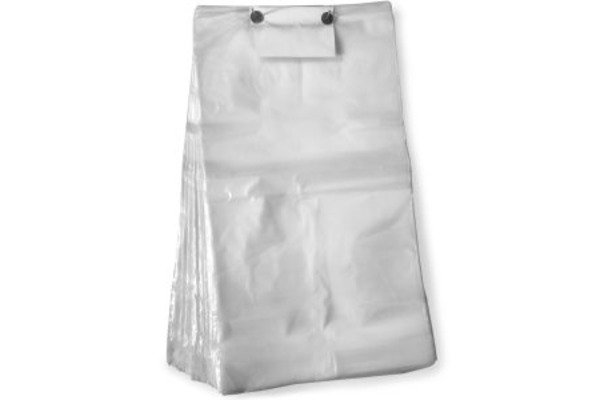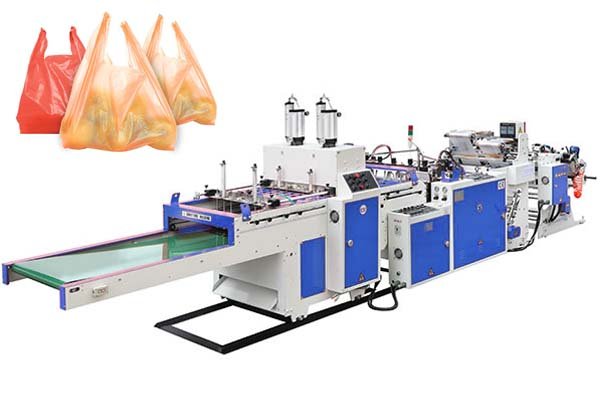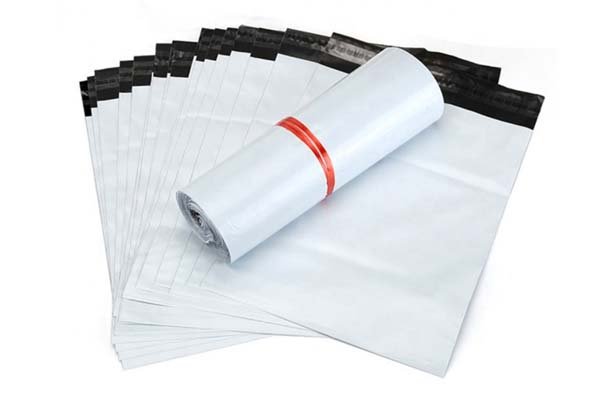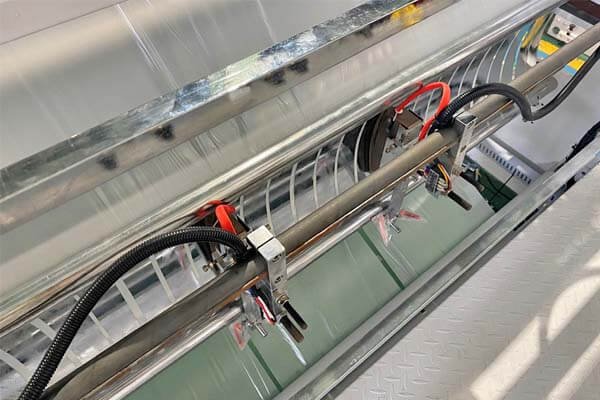
Poly bagging is the process of placing a product into a plastic bag, typically made from polyethylene, for protection and containment. This method is essential for safeguarding items from moisture, dust, and handling damage during shipping, storage, and retail display.
The process involves more than just inserting an item into a bag. It requires selecting the appropriate plastic film and using machinery to create secure, consistent packages. BagMec® manufactures automated systems that handle every step—from forming the bag to sealing it. These machines are engineered to accommodate various materials and features, supporting efficient and scalable packaging operations.
Poly bagging starts with material selection. Low-density polyethylene (LDPE)1 is flexible and ideal for clothing, while high-density polyethylene (HDPE) is sturdier and used for items like grocery bags. Machines can also process biodegradable materials2 such as PLA. A heated sealing bar3 then forms a strong seam, which is crucial for protecting contents. Additional features like zippers, tear strips, or handles can also be integrated, depending on industry needs.
Why Should Plastic Bags Not Be Banned?
Plastic bags are frequently targeted for environmental bans, but such decisions often overlook broader consequences. Alternatives like paper or cotton may appear more eco-friendly but tend to have a higher overall environmental impact.
Plastic bag bans can unintentionally increase environmental harm, as alternatives typically consume more resources and energy throughout their lifecycle.

A complete lifecycle analysis—examining a product from production to disposal—often reveals that plastic bags, when managed properly, are more resource-efficient than other options. The conversation around sustainability should focus on practical solutions grounded in data.
The Environmental Impact of Alternatives
A closer look at paper and cotton bags reveals key environmental trade-offs:
-
Paper Bags: Made from trees, paper bags require significant water, chemicals, and energy to produce—about four times more than plastic bags. Their weight and volume also make transport less efficient, increasing fuel consumption. Despite being recyclable, paper bags lose functionality when wet.
-
Cotton Tote Bags: Cotton production is resource-heavy, demanding vast water and pesticide use. According to a study by the Danish Ministry of Environment and Food, a conventional cotton bag must be reused over 7,000 times to match the environmental impact of a single-use plastic bag. Organic cotton bags require even more reuses. Additionally, they must be washed regularly, which adds further water and energy use.
Lifecycle Comparison Table
| Feature | HDPE Plastic Bag | Paper Bag | Cotton Tote Bag |
|---|---|---|---|
| Raw Material | Petroleum by-product | Trees | Cotton Plant |
| Water Usage (Production) | Low | High | Very High |
| Energy Usage (Production) | Low | High | Very High |
| Greenhouse Gas Emissions | Low | High | Very High |
| Reusability | Moderate | Low | High |
| Recyclability | Yes (if clean) | Yes (if dry) | Difficult |
| Durability | High | Low | High |
The Real Problem: Waste Management
Environmental issues tied to plastic bags stem more from poor waste management4 than from the material itself.
-
Infrastructure Improvements: Developing better recycling systems is key. Properly collected plastic bags can be recycled into lumber, fuel, or new bags. Emphasizing a circular economy5 would help turn waste into usable material.
-
Manufacturing Innovation: Machine manufacturers like BagMec® contribute by improving efficiency. Their equipment uses less energy and produces less waste. Machines can also process recycled plastics and biodegradable films, helping businesses adopt sustainable practices.
-
Economic Considerations: Plastic bags are inexpensive to produce and support a global manufacturing workforce. Bans could raise costs for businesses and consumers and negatively impact employment in related industries.
How Are Different Types of Poly Bags Made?
Poly bags are produced by specialized machinery that performs tasks like sealing, cutting, and feature integration, depending on the bag type.
Different poly bags require machines with distinct functions—such as die-cutting for T-shirt bags or zipper sealing for resealable pouches.

While the foundation of bag making involves film unwinding, sealing, and cutting, the process is tailored to the product’s intended use.
The Core Process: Sealing and Cutting
-
Unwinding and Feeding: A roll of flat plastic film is unwound. Advanced systems like BagMec®'s "Smart Tension Control" ensure smooth, wrinkle-free feeding.
-
Sealing: A heated bar fuses the film’s layers to form strong seams. The sealing technique (bottom or side) depends on the bag type.
-
Cutting: After sealing, blades or perforators cut the film into individual bags. Perforation is common for products like garbage bags on a roll.
Machine Specialization for Different Bags
| Bag Type | Key Machine Process | BagMec® Machine Example | Price Range (USD) |
|---|---|---|---|
| T-Shirt Bag | Film folding, bottom sealing, die-cutting handles | T-Shirt Bag Making Machine | $17,000 – $32,000 |
| Courier Bag | Side sealing, adhesive strip, tear-line perforation | Courier Bag Machine | $23,000 – $35,000 |
| Loop Handle Bag | Handle welding post-formation | Loop Handle Bag Making Machine | $33,000 – $38,000 |
| Zipper Bag | Zipper profile heat-sealed into film | Zipper Bag Making Machine | $15,000 – $22,000 |
| Wicketer Bag | Hole punching, wicket stacking | Wicketer Bread Bag Machine | $69,000 – $88,000 |
Automation and Advanced Features
Modern machines are controlled through PLC systems with touchscreen interfaces. Operators can set parameters like bag length, sealing temperature, and speed. Optional modules allow for in-line printing, embossing, and QR code insertion—like those developed by BagMec® for logistics applications.
What Industries Rely on Poly Bagging?
Poly bagging is a critical packaging method across multiple sectors due to its versatility and protective benefits.
Sectors such as e-commerce, food, and healthcare depend on poly bagging for product protection, hygiene, and efficient distribution.

From clothing to medical supplies, poly bags ensure goods are clean, intact, and ready for consumers.
E-commerce and Retail
- Requirement: Protection from moisture and damage, secure shipping, and attractive presentation.
- Common Solutions: Clear poly bags for apparel and opaque mailers with adhesive strips for direct shipping.
- Machine Application: High-speed machines for bag production at fulfillment centers. BagMec® systems can produce 2,500 bags/hour.
Food and Beverage
- Requirement: Freshness, hygiene, and convenience.
- Common Solutions: Food-safe poly bags, resealable pouches, wicketer bread bags.
- Machine Application: FDA-compliant machinery6 designed for hygienic operation and efficiency. BagMec® helped reduce material waste by 18% with its FFS systems.
Medical and Hygiene
- Requirement: Sterile, tamper-evident packaging for sensitive items.
- Common Solutions: Diaper bags, specimen bags, surgical packaging.
- Machine Application: Equipment built for cleanroom standards. BagMec® machines meet ISO 13485 compliance7, including sterile chamber options.
Conclusion
Poly bagging is a vital process in global manufacturing and logistics, offering product protection and operational efficiency. While environmental concerns are valid, banning plastic bags may lead to unintended consequences. A more effective solution lies in innovation, recycling, and responsible production practices—areas where manufacturers like BagMec® are actively making an impact.
-
Learn about LDPE's flexibility and its ideal applications in packaging. ↩
-
Understand the advantages of using biodegradable materials in packaging. ↩
-
Find out how heated sealing bars create strong seams for product protection. ↩
-
Learn about strategies to improve waste management and recycling systems. ↩
-
Explore the concept of a circular economy and its role in sustainability. ↩
-
Learn about the importance of FDA compliance in food and medical packaging. ↩
-
Discover the significance of ISO 13485 compliance in medical device manufacturing. ↩






